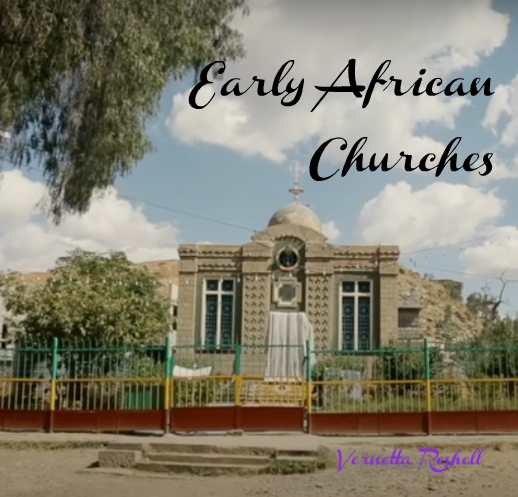26 But an angel of the Lord said to Philip, “Get up and go south to the road that runs from Jerusalem down to Gaza.” (This is a desert road). 27 So he got up and went; and there was an Ethiopian eunuch [a man of great authority], a court official of Candace, queen of the Ethiopians, who was in charge of all her treasure. He had come to Jerusalem to worship,
Acts 8:26–27 AMP
This week we’ll continue with the Lineage of the Black Church series. Read last week’s post to understand where we are in early African Christian Church history.
I wanted to take a look at two early Christian churches in Africa that still have roots and a presence today. When we think of the early church and building we often think of Europe but not Africa. That’s the perception that’s been sold to us. However, Christianity has been in Africa since the First century. I have shared that in several posts so far. Let’s take a look at two churches that still have roots to the early church in Africa.
We’ll look at the Coptic Orthodox Church of Alexandria and the Ethiopian Orthodox Tewahedo Church. Please know there were Christian churches in Sudan, the kingdoms of Nobatia, Makuria & Alodia as well as in the Maghreb. These were ancient civilizations that are present-day countries such as Sudan, Egypt, Algeria, Libya, Mauritania, Morocco, Tunisia. Many of these are now Islam majority countries but at one time they held a strong Christian foundation. Several of these kingdoms belonged to the Kingdom of Kush.
Again, you can do your own research and see how far Christianity reached in the first several centuries after the birth of Christ in North and Eastern Africa.
Let’s start with the Ethiopian Orthodox Tewahedo Church.
Now there is a claim that one of their churches has the Ark of the Covenant that Moses carried during the Exodus. I have a video below that will go into more detail. They do have Bishops and I guess you can call them branches around the world stemming from this church. Another fun fact is Ethiopia is the second country after Armenia to proclaim Christianity as the official state religion. Christianity officially came to Ethiopia in the 4th Century under King Ezana.
Currently at my church we’re doing a 21-day Daniel fast for our ‘Something Different’ series. I learned that the devout believers have a fasting schedule of 250 days. Y’all. Wow, they may as well just be vegans. So this is the part of the church I will share with you that I found interesting and something I’m currently doing as I write this blog post.
They have 7 main fasts:
- Fast for Hudadi or Abiye Tsome (divided into 3 separate parts): Tsome Hirkal is 8 days to commemorate an early church figure, Tsome Arba is 40 days for Lent and Tsome Himamat is 7 days commemorating the Holy Week. Tsome means Great Lent. So this fast is for 55 days. When I did my fast I thought 40 days was the longest. Nope, just learned this is the longest fast I’ve researched.
- Fast of the Apostles: This begins after Pentecost and can last 10-40 days. They do this as the Apostles did. Meaning after they received the Holy Spirit they will do this fast.
- Fast of Tsome Dihnet: This is a Wednesday and Friday fast from the day after Pentecost leading up to Easter. Wednesdays commemorates the plot organized to kill Jesus by the high priests and Fridays commemorate the crucifixion of Jesus. This is not done the 50 days after Easter.
- Fast of Dormition: It lasts for 16 days. It commemorates the “falling asleep” or death of Mary the Theotokos and her bodily resurrection before it ascends to Heaven. Who is she? This is the mother of Jesus y’all. She has different titles in different branches of the Christian church.
- Fast preceding Christmas: It lasts for 40 days. It usually ends on Christmas Eve during the season of Advent except in leap years.
- Fast of Nineveh: It commemorates the preaching of Jonah (from the Old Testament). It is on Monday, Tuesday and Wednesday of the third week before Lent.
- Gahad of Timkat: It is the fast on the eve of Epiphany. Epiphany is the celebration of the revelation of God incarnate as Jesus Christ.
Y’all I was shocked by this. If you’ve read my blog post about fasting you would understand the benefits, reasoning and revelations you can yield from fasting. There’s so much more about this church but not enough space. So I’ll let you check out these 2 videos below about churches in Ethiopia I found interesting before we head to the second church I wanted to share with you.
Ethiopia’s church in the sky is not really related to today’s post but it is. I believe this is the world’s highest church. You gotta see how they get to the church.
You can check out this episode in the History of Africa series where supposedly Queen of Sheeba had a love child with someone from the Bible. And the Ethiopian royal family to this day say they are descendants of the love child of Queen of Sheeba and her lover. Whew…y’all have to watch because you won’t believe who it is. Anyway, it’ll confirm how Africans embraced Christianity centuries before colonizers arrived on the shores of the continent.
Now let’s get to Egypt. We had a great time in Ethiopia.
The Coptic Orthodox Church of Alexandria
The evolution of the power and presence of this church changed quickly and drastically with the arrival of Islam. Now they are a persecuted minority. They’ve had to move their headquarters from Alexandria to Cairo. We’ll get more into that next week. This church, however, still laid the foundation of many things Christian churches still do to this day.
The church was established by Saint Mark around 42AD. Y’all know Mark. He wrote the Book of Mark. That one. The kingdoms listed above like the Aksumite empire and some Nubian Kingdoms is where the church expanded to before Islamic conquerors arrived in 639AD. Unlike the Ethiopian Orthodox church, the Coptic Orthodox church lost power and prestige early, became a minority religion yet still maintain roots to this day. So we can give it up for the determined ones who wouldn’t let this church die out.
19 In that day there will be an altar to the Lord in the midst of the land of Egypt, and a memorial stone to the Lord near its border.
Isaiah 19:19 AMP
Christian monasticism was born in Egypt. It is the devotional practice of people who choose to live ascetic and cloistered lives. Y’all I think this is like the convent. So it was the Egyptian church not the Roman church that birthed priests and nuns who lived in seclusion. In Egypt they went into the desert to pray and work thus creating the perfect opportunity to not be bothered by other people. Many of those monasteries still exist and are flourishing today with new vocations.
As you can see, I had fun learning more as I dove deep into research about early African Churches. I wanted to share how these churches not just were birthed in the early centuries but exist today with lineages that still reaches modern people.
Next week we’ll talk about how the lineage was disrupted.


Leave a Reply